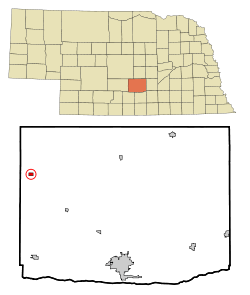Miller, Nebraska
Miller is a village in Buffalo County, Nebraska, United States. It is part of the Kearney, Nebraska Micropolitan Statistical Area. As of the 2010 census, the village population was 136.
Miller, Nebraska | |
|---|---|
Downtown Miller | |
 Location of Miller, Nebraska | |
| Coordinates: 40°55′41″N 99°23′32″W | |
| Country | United States |
| State | Nebraska |
| County | Buffalo |
| Area | |
| • Total | 0.38 sq mi (0.98 km2) |
| • Land | 0.38 sq mi (0.98 km2) |
| • Water | 0.00 sq mi (0.00 km2) |
| Elevation | 2,320 ft (707 m) |
| Population | |
| • Total | 136 |
| • Estimate (2019)[3] | 131 |
| • Density | 345.65/sq mi (133.58/km2) |
| Time zone | UTC-6 (Central (CST)) |
| • Summer (DST) | UTC-5 (CDT) |
| ZIP code | 68858 |
| Area code(s) | 308 |
| FIPS code | 31-32130[4] |
| GNIS feature ID | 0831311[5] |
History
Miller was laid out in its present site in 1890 when the railroad built through that territory.[6] It was named for Dr. George L. Miller, who was instrumental in bringing the railroad to the area.[6] Miller was incorporated as a village in 1890.[7]
Geography
Miller is located at 40°55′41″N 99°23′32″W (40.928001, -99.392353).[8]
According to the United States Census Bureau, the village has a total area of 0.38 square miles (0.98 km2), all land.[9] The village is located at 40.92699 N, 99.39054 W.
Demographics
| Historical population | |||
|---|---|---|---|
| Census | Pop. | %± | |
| 1900 | 194 | — | |
| 1910 | 330 | 70.1% | |
| 1920 | 223 | −32.4% | |
| 1930 | 263 | 17.9% | |
| 1940 | 205 | −22.1% | |
| 1950 | 179 | −12.7% | |
| 1960 | 137 | −23.5% | |
| 1970 | 130 | −5.1% | |
| 1980 | 147 | 13.1% | |
| 1990 | 130 | −11.6% | |
| 2000 | 156 | 20.0% | |
| 2010 | 136 | −12.8% | |
| Est. 2019 | 131 | [3] | −3.7% |
| U.S. Decennial Census[10] | |||
2010 census
As of the census[2] of 2010, there were 136 people, 59 households, and 34 families living in the village. The population density was 357.9 inhabitants per square mile (138.2/km2). There were 66 housing units at an average density of 173.7 per square mile (67.1/km2). The racial makeup of the village was 95.6% White and 4.4% from other races. Hispanic or Latino of any race were 6.6% of the population.
There were 59 households, of which 32.2% had children under the age of 18 living with them, 40.7% were married couples living together, 8.5% had a female householder with no husband present, 8.5% had a male householder with no wife present, and 42.4% were non-families. 35.6% of all households were made up of individuals, and 18.7% had someone living alone who was 65 years of age or older. The average household size was 2.31 and the average family size was 3.00.
The median age in the village was 41.3 years. 27.2% of residents were under the age of 18; 3% were between the ages of 18 and 24; 25.7% were from 25 to 44; 25.8% were from 45 to 64; and 18.4% were 65 years of age or older. The gender makeup of the village was 51.5% male and 48.5% female.
2000 census
As of the census[4] of 2000, there were 156 people, 64 households, and 38 families living in the village. The population density was 423.4 people per square mile (162.8/km2). There were 72 housing units at an average density of 195.4 per square mile (75.1/km2). The racial makeup of the village was 100.00% White.
There were 64 households, out of which 28.1% had children under the age of 18 living with them, 51.6% were married couples living together, 6.3% had a female householder with no husband present, and 39.1% were non-families. 31.3% of all households were made up of individuals, and 9.4% had someone living alone who was 65 years of age or older. The average household size was 2.44 and the average family size was 3.05.
In the village, the population was spread out, with 25.6% under the age of 18, 11.5% from 18 to 24, 26.3% from 25 to 44, 25.0% from 45 to 64, and 11.5% who were 65 years of age or older. The median age was 38 years. For every 100 females, there were 102.6 males. For every 100 females age 18 and over, there were 110.9 males.
The median income for a household in the village was $33,125, and the median income for a family was $36,875. Males had a median income of $35,000 versus $16,875 for females. The per capita income for the village was $13,968. None of the families and 4.1% of the population were living below the poverty line.
References
- "2019 U.S. Gazetteer Files". United States Census Bureau. Retrieved July 26, 2020.
- "U.S. Census website". United States Census Bureau. Retrieved 2012-06-24.
- "Population and Housing Unit Estimates". United States Census Bureau. May 24, 2020. Retrieved May 27, 2020.
- "U.S. Census website". United States Census Bureau. Retrieved 2008-01-31.
- "US Board on Geographic Names". United States Geological Survey. 2007-10-25. Retrieved 2008-01-31.
- "Miller, Buffalo County". Center for Advanced Land Management Information Technologies. University of Nebraska. Retrieved 30 July 2014.
- Bassett, Samuel Clay (1916). Buffalo County, Nebraska, and Its People: A Record of Settlement, Organization, Progress and Achievement, Volume 1. S.J. Clarke Publishing Company. p. 287.
- "US Gazetteer files: 2010, 2000, and 1990". United States Census Bureau. 2011-02-12. Retrieved 2011-04-23.
- "US Gazetteer files 2010". United States Census Bureau. Archived from the original on 2012-07-02. Retrieved 2012-06-24.
- "Census of Population and Housing". Census.gov. Retrieved June 4, 2015.